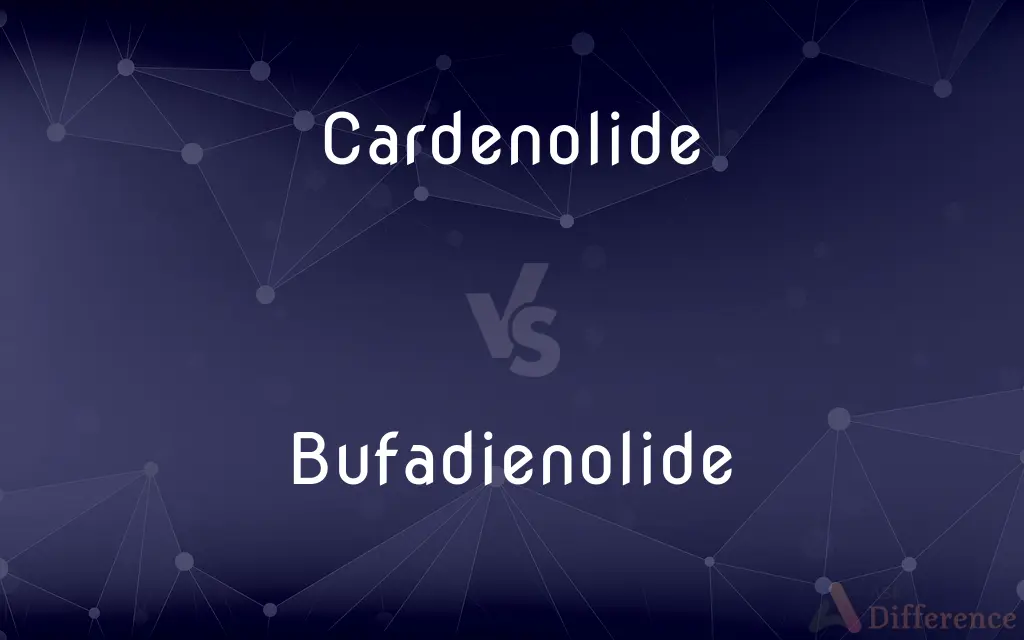Cardenolide vs. Bufadienolide — What's the Difference?
Edited by Tayyaba Rehman — By Fiza Rafique — Updated on March 25, 2024
Cardenolides are a type of steroid that affect the heart by inhibiting the Na+/K+-ATPase enzyme, while bufadienolides also inhibit this enzyme but are derived from different sources, such as toads.

Difference Between Cardenolide and Bufadienolide
Table of Contents
ADVERTISEMENT
Key Differences
Cardenolides, such as digoxin, are steroids with a specific structure that allows them to bind to and inhibit the Na+/K+-ATPase enzyme in heart cells. This action increases the force of heart contractions, making them useful in treating heart failure and certain arrhythmic conditions. Whereas, bufadienolides, including bufalin, share a similar mechanism of action but differ chemically and are often sourced from toads and other amphibians. They too can influence heart function and have been explored for their potential in cancer treatment.
Cardenolides are primarily found in plants, such as Digitalis purpurea (foxglove), and have a long history of use in medicine. They are known for their ability to improve the efficiency of the heart and manage symptoms of heart failure. On the other hand, bufadienolides are not only found in certain plants but also in animal secretions, with a notable example being the secretion of the poison dart frog. Their broader range of sources adds complexity to their study and use.
While both cardenolides and bufadienolides act on the same cellular enzyme, their distinct molecular structures lead to differences in their pharmacokinetics and interactions within the body. This means that they can have different absorption, distribution, metabolism, and excretion profiles, affecting their overall efficacy and safety. Bufadienolides, for instance, might exhibit a stronger affinity for the Na+/K+-ATPase enzyme in certain conditions, potentially offering different therapeutic benefits or risks.
The therapeutic applications of cardenolides are well-established, particularly in the management of heart conditions, where their dosing and effects are well-understood. Bufadienolides, while also showing promise in similar areas, have been the subject of more recent research, particularly in oncology, where they are being investigated for their ability to induce apoptosis in cancer cells. This suggests a potentially broader therapeutic role for bufadienolides beyond cardiology.
Despite their shared mechanism of action, the safety profiles of cardenolides and bufadienolides may differ significantly. Cardenolides have a narrow therapeutic window, and their use requires careful monitoring to avoid toxicity. Bufadienolides, given their varied sources and potential for different toxic effects, necessitate even more cautious approach in research and potential therapeutic use, underlining the importance of understanding their specific pharmacological characteristics.
ADVERTISEMENT
Comparison Chart
Source
Primarily plants (e.g., Digitalis species)
Plants and animals (e.g., toads)
Mechanism
Inhibit Na+/K+-ATPase enzyme
Inhibit Na+/K+-ATPase enzyme
Primary Use
Heart failure and arrhythmias treatment
Investigated for heart conditions and cancer treatment
Molecular Structure
Specific steroid structure
Different steroid structure with variations
Safety and Monitoring
Narrow therapeutic window, requires careful monitoring
Potentially broader effects, necessitating cautious research and use
Compare with Definitions
Cardenolide
Heart-affecting steroids found in certain plants.
Digoxin, derived from foxglove, is used to treat heart failure.
Bufadienolide
Steroids found in plants and amphibian secretions.
Bufalin, a bufadienolide from toad venom, has been studied for its anti-cancer properties.
Cardenolide
Compounds inhibiting the Na+/K+-ATPase enzyme.
Through inhibition, cardenolides increase the force of heart contractions.
Bufadienolide
Investigated for cancer treatment potential.
Research into bufadienolides includes their ability to trigger cancer cell apoptosis.
Cardenolide
Have a narrow therapeutic window.
The dose of cardenolides is carefully monitored to avoid toxicity.
Bufadienolide
Act on the heart's Na+/K+-ATPase enzyme.
Bufadienolides can potentiate heart muscle contractions similarly to cardenolides.
Cardenolide
Used medicinally for heart conditions.
Cardenolides are prescribed to improve heart efficiency and control rhythm.
Bufadienolide
Require cautious research due to their potent effects.
The therapeutic use of bufadienolides is limited by the need for thorough safety evaluation.
Cardenolide
Steroids that increase cardiac output.
Cardenolides have been essential in managing symptoms of heart disease.
Bufadienolide
Derived from a broader range of sources.
Unlike cardenolides, bufadienolides are sourced from both plants and animals.
Cardenolide
A cardenolide is a type of steroid. Many plants contain derivatives, collectively known as cardenolides, including many in the form of cardenolide glycosides (cardenolides that contain structural groups derived from sugars).
Bufadienolide
Bufadienolide is a chemical compound with steroid structure. Its derivatives are collectively known as bufadienolides, including many in the form of bufadienolide glycosides (bufadienolides that contain structural groups derived from sugars).
Cardenolide
(organic chemistry) Any of many steroid lactones present in plants as glycosides; they are all toxic, affecting the heart
Bufadienolide
Any of a class of toxic steroids present in some plants and secreted by some toads through the skin as a defense; sometimes present as a glycoside.
Common Curiosities
How do cardenolides and bufadienolides work?
They increase the force of heart contractions by inhibiting the Na+/K+-ATPase enzyme, which is crucial for cardiac function.
Are bufadienolides used in cancer treatment?
Bufadienolides are being investigated for their potential in cancer treatment, particularly for their ability to induce apoptosis in cancer cells.
How do the safety profiles of cardenolides and bufadienolides compare?
Both have potent effects with a need for careful monitoring, but bufadienolides, due to their varied sources and effects, require a more cautious approach.
Can cardenolides and bufadienolides be considered the same?
Although they share a mechanism of action, their differences in structure, source, and safety profiles distinguish them significantly.
Why is careful monitoring required when using cardenolides?
Due to their narrow therapeutic window, even small doses above the therapeutic range can lead to toxicity.
What are cardenolides and bufadienolides?
Cardenolides and bufadienolides are both types of steroids that inhibit the Na+/K+-ATPase enzyme, affecting heart function, but they differ in structure and source.
What makes bufadienolides a subject of interest in oncology?
Their ability to trigger apoptosis in cancer cells makes them a promising area of research for cancer treatment.
What are the main sources of cardenolides and bufadienolides?
Cardenolides are mainly found in certain plants like Digitalis, while bufadienolides are derived from both plants and animals, such as toads.
What are the therapeutic uses of cardenolides?
Cardenolides are primarily used to treat heart failure and arrhythmias due to their effect on cardiac output.
What research is being done on bufadienolides?
Research on bufadienolides focuses on their role in heart conditions and their potential as anti-cancer agents.
How are cardenolides and bufadienolides administered?
They are administered under medical supervision, often orally, with dosage carefully managed to avoid adverse effects.
Share Your Discovery

Previous Comparison
Deposit vs. Caution
Next Comparison
Repaint vs. PaintAuthor Spotlight
Written by
Fiza RafiqueFiza Rafique is a skilled content writer at AskDifference.com, where she meticulously refines and enhances written pieces. Drawing from her vast editorial expertise, Fiza ensures clarity, accuracy, and precision in every article. Passionate about language, she continually seeks to elevate the quality of content for readers worldwide.
Edited by
Tayyaba RehmanTayyaba Rehman is a distinguished writer, currently serving as a primary contributor to askdifference.com. As a researcher in semantics and etymology, Tayyaba's passion for the complexity of languages and their distinctions has found a perfect home on the platform. Tayyaba delves into the intricacies of language, distinguishing between commonly confused words and phrases, thereby providing clarity for readers worldwide.














































